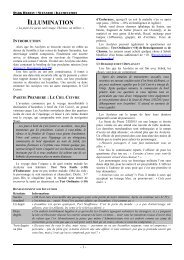Create successful ePaper yourself
Turn your PDF publications into a flip-book with our unique Google optimized e-Paper software.
42backgrounds—with the possible exception of backgroundsof raging fire. Conspicuousness suits thesebeasts just fine. They have no interest in hiding fromlesser creatures.Two of the frills on the sides of a red dragon’s headaid in its hearing ability. Though not external ears—red <strong>dragons</strong>, like all <strong>chromatic</strong> <strong>dragons</strong>, have internalears only—these frills help the dragon pick up soundsand determine directionality.Red <strong>dragons</strong> smell of smoke and sulfur. The airaround them sometimes shimmers, as though viewedthrough a heat mirage.White DragonsWhite <strong>dragons</strong>—also called ice <strong>dragons</strong> or glacialwyrms—have a reputation as dull, stupid creatures.They do not deserve it. Although white <strong>dragons</strong> areremarkably bestial, they are as intelligent as other<strong>chromatic</strong> <strong>dragons</strong>. They care little for intricateschemes or political power, preferring to live theirlives as hunters and collectors of treasure. They relymore on instinct than on intellect. Although they stilllive long and look to the distant future, they do notworry about the future to the extent that their cousinsdo. They prefer merely to keep themselves comfortablyfed and housed.Like all capable predators, white <strong>dragons</strong> are mastersof their territories. They know the good hidingspots and optimal ambush points. They hunt not onlywell, but brutally. They kill swiftly and efficiently.They lack the cruelty of black <strong>dragons</strong> and the ferocityof reds. They also lack those <strong>dragons</strong>’ inclinationto engage with or manipulate intruders or neighbors.Unless potential victims quickly offer solid reasonsnot to kill them, white <strong>dragons</strong> likely slay first, eatsecond, and never consider asking questions. TheCHAPTER 1 | Dragon Lorefew offers known to have saved fast-talking travelersincluded gifts of gems with promises of more gems tocome or, even better, gifts and promises of more meatthan the travelers themselves would provide if eaten.Like all <strong>chromatic</strong> <strong>dragons</strong>, white <strong>dragons</strong> lookdown on other creatures. In the white dragon’s case,this attitude is evidence of its tendency to view allliving creatures as potential prey. Prey is, after all,inferior to the hunter strong enough to eat it.Rarely, if ever, can a community negotiate peacefulcoexistence with a white dragon whose territory bordersit. Members of a community might have a slimchance of convincing a dragon to leave their livestockalone, at least for a while, if they display a significantshow of force or give a truly magnificent bribe. Barringthese options, however, nothing but the dragon’sdeath can stop it from hunting the people’s herdanimals—and probably the people themselves.As animalistic hunters, white <strong>dragons</strong> have littlepreference among types of prey. They attack and eatthe most convenient creatures worth the trouble ofkilling. Because farmers’ cattle offer a lot more meat,they interest a white dragon more than the farmersthemselves—but a dragon does not balk at eatingavailable sentient beings. White <strong>dragons</strong> preferfrozen foods, burying their prey in snowbanks orwalls of ice for days or weeks before consuming it.White <strong>dragons</strong> possess a few traits not purelypredatory. Like reds and blues, they have especiallylong memories for grudges and insults. They mightseek revenge for slights many years after erring partieshave forgotten them.Lairs and TerrainWhite <strong>dragons</strong> truly love the cold. The vast majorityof them live either on mountain peaks coveredin snow year-round or on tundra or glacial plains.White <strong>dragons</strong> particularly benefit from the way icyterrain slows their prey, because such terrain does notimpede the <strong>dragons</strong> themselves.White <strong>dragons</strong> do not need bitter cold, however.Some of them dwell in mountain peaks not nearly asfrozen as they prefer. Some might even live in forests.Such lairs occasionally cause white <strong>dragons</strong> to comeinto conflict with red, blue, or green <strong>dragons</strong>—battlesthe white <strong>dragons</strong> would rather avoid, because other<strong>dragons</strong> of comparable age are more powerful. Also,as born hunters, white <strong>dragons</strong> resent expendingenergy that does not result in the acquisition of prey.As with most <strong>dragons</strong>, a white prefers to lair ina cave: in this case, either in a deep mountain creviceor a shallower hollow in ice. In an area wherethe temperature never rises above freezing, a whitedragon might create a cave out of tightly packed snowand freeze it into hard ice through judicious applicationof its breath weapons.TARA RUEPING









